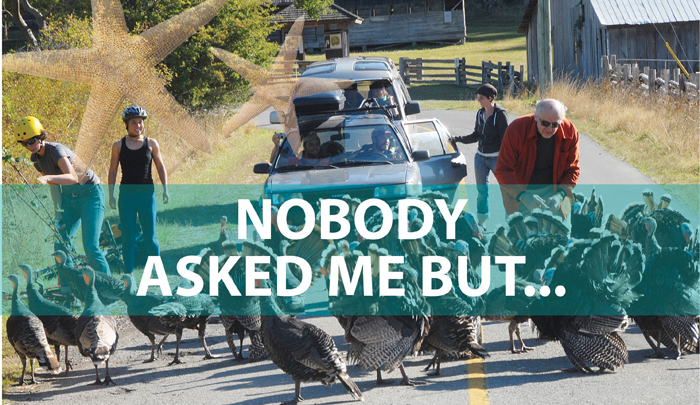It seems like wherever we go these days and whomever we chat with, everybody wants to talk about their family tree. It’s as if all the last few remnants of the “me” generation have suddenly morphed into the “where did me come from” generation. We so want to believe that we are part of something much bigger and older. What many are seeking is some kind of a link to what came before. With such an uncertain future staring us in the face, it’s no wonder we are looking back behind us in search of a connection with the past.
We all like to think that we have sprouted from family trees standing proud and tall with branches extending wide and strong. What we refuse to admit is the possibility that there might be more than a touch of root rot at the very foundation of our family lineage. We’ve been told over and over again that great-great-great grandfather Jedidiah was a pillar of society and deacon of his church, but what has conveniently been glossed over were his penchant for drink, gambling and having a warm butt nestled in his lap.
On the other hand, the rootstock of the old dynasty may be tried and true, but somewhere along the cycles of growth, one of our ancestors may have branched off in a southerly direction, thus exposing the familial name to the scandalous equivalent of powdery mildew or perennial canker. Great-aunt Sophia claimed to be a dowager contessa who had been stripped of her title and regal Hungarian estates after the Battle of Hapsburg, but she never really came any closer to aristocracy than that bag of Earl Grey tea she plunked in her teapot at three o’clock every afternoon. That long-awaited telegram which was supposed to verify that she had been reunited with her fortune never did arrive, and in the end, her branch on the family tree just seemed to wither away with the years.
Exploring the many twists and turns that comprise the saga of your family no longer has to mean fetching a bunch of scrapbooks down from the attic and dusting off the pages. Discovering the family history can be as close as a click of your computer. The field of sites offering you a leg up in finding possible living relatives is both crowded and competitive. The leader among these genealogical heritage internet corporations is Ancestry, but there exist many more clawing to catch up. Among these you will find MyHeritage, Findmypast, Genes Reunited and OneGreatFamily. The names may sound like a singles club for broken-hearted genes, but it’s all about big business. They even supply you with DNA kits that will link your personal biology with those of others who not only don’t know that you are related, but would probably rather not be made aware of your existence at all.
It is said that the most confusing day of the year on Salt Spring is Father’s Day, on account of the fact that nobody really knows for sure who is related to whom and how that relationship came about in the first place. As a case in point, Willie Nelson sings a song about him marrying a widow who has a grownup daughter who then marries his father. This makes his dad his son-in-law and his daughter becomes his mother. The familial bonds become weirder and weirder until the song reaches the chorus (also the title of the song): I Am My Own Grandpa. Salt Spring is living proof that woven relationships such as these are not so far-fetched.
There exists an entirely different landscape of genealogy that has yet to be tapped into by the ancestry industry. As far as we know, nobody has begun researching past life and reincarnation family trees. Using these cosmic models, there is no reason why you can’t trace your family history back through distant geographies, time eras and dimensions. You may find your personal tree has pulled up its roots and skedaddled over to a whole different woodlot, thus increasing the number of genealogical possibilities exponentially.
Reincarnation ancestry, however, may open up a Pandora’s box of surprises. Your search may uncover evidence that you share genetic material with King Tutankhamun of ancient Egypt and have a sizable claim to the vast fortune of gold and precious jewels buried in his tomb, but there is also solid documentation that you may instead be a branch off the family tree of a 12th-century fruit fly.
Perhaps it would be wiser to abandon the concept of a family tree and instead adopt the model that we are all connected through a family forest. Each tree in the forest is actually part of this vast organism held together by a network of fungal threads called mycelia. In this way, each tree in the forest is actually only a branch of the organism and can communicate with the rest of the forest entity through the mycelia network. Thusly, because they are all inter-connected, no single tree can stand on its own, nor can it draw attention to its successful growth, without acknowledging that it was a group effort.
The same can be said about this recent obsession with ancestry and family lineage. We are all in this together. Whether we survive or collapse as a species is dependent on how we cooperate instead of compete for the best and the most of everything. Maybe it’s time to bonsai the old family tree before it all becomes a tangle of intertwined branches and suckers.
Nobody asked me, but tracing a family tree on Salt Spring may be about as productive as filling your gumboots with water before you wear them out in the rain. No matter how carefully you tippy-toe your way around, you’re bound to get soaked in the end.

